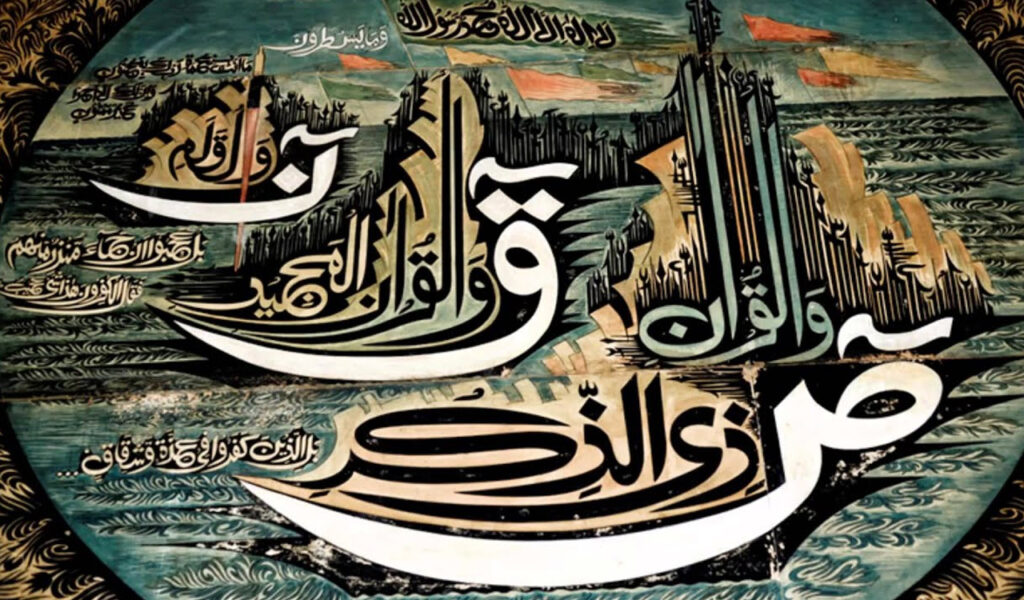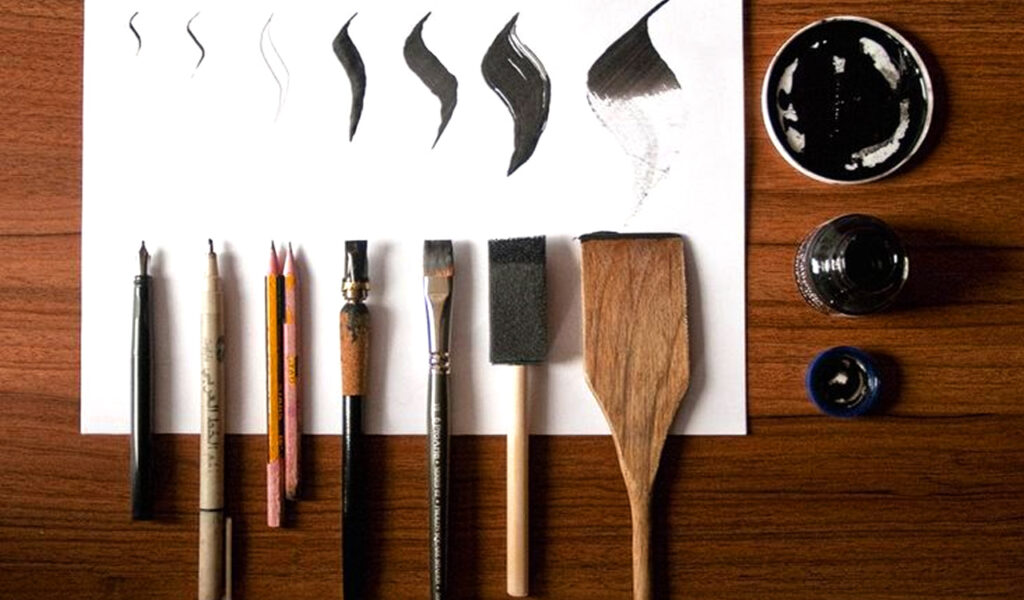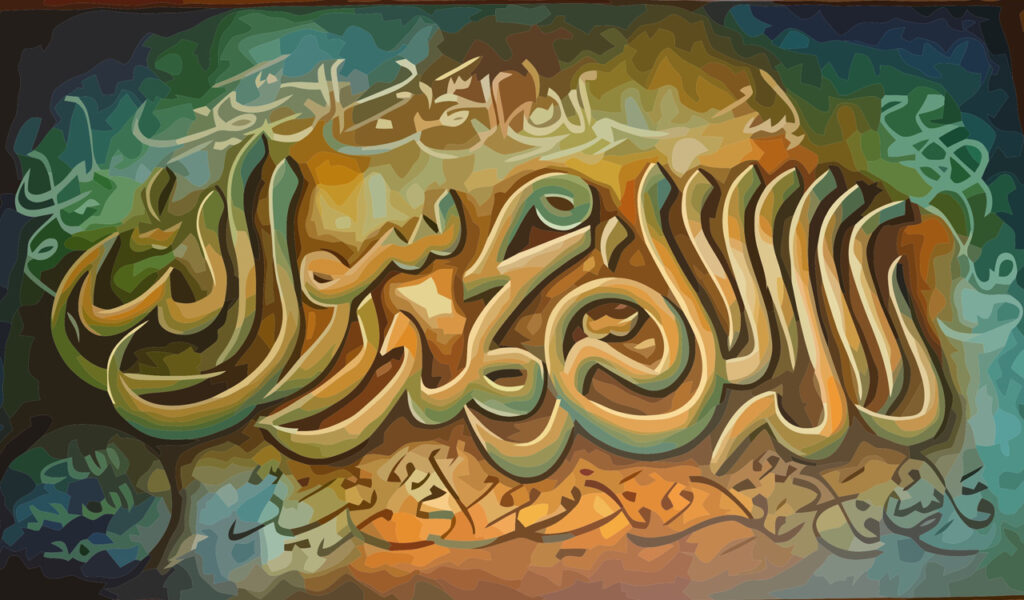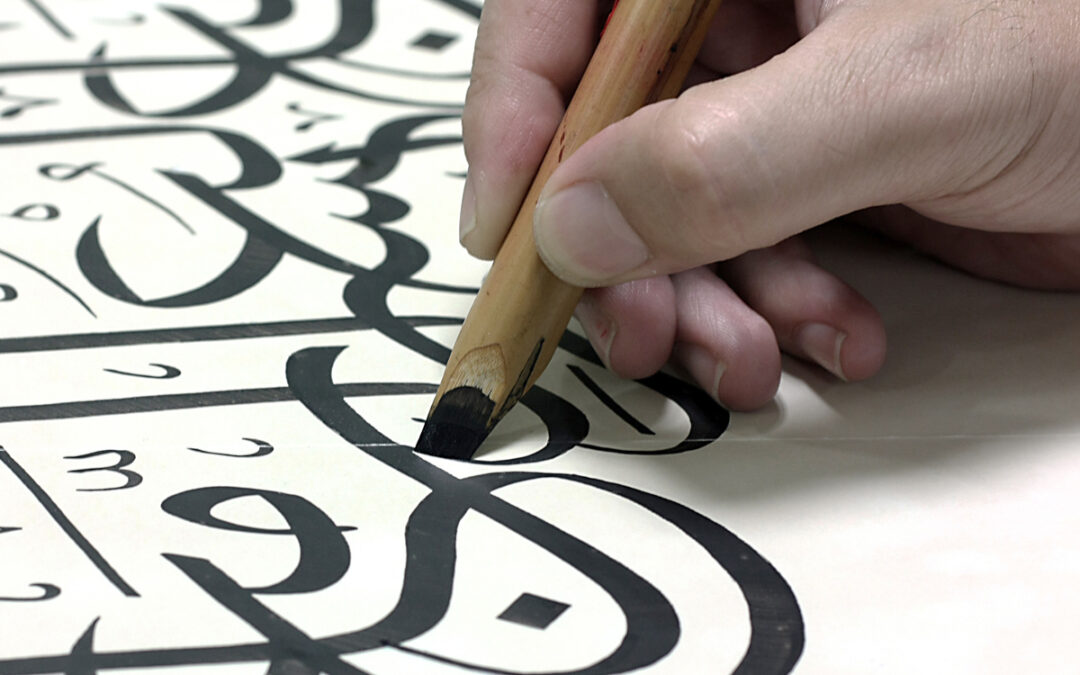Briefly introduce Arabic calligraphy as a revered and ancient art form. Highlight the cultural significance and historical evolution of Arabic Hand Lettering. To provide a comprehensive guide to the artistic techniques and styles of Arabic calligraphy.
Arabic calligraphy is a captivating art form that has been practiced for centuries, combining aesthetics with the written word. It is a testament to the cultural richness and historical significance of the Arabic script. The artistic techniques and styles employed in Arabic calligraphy have evolved over time, influenced by various factors such as regional traditions, religious practices, and individual creativity. This article explores the diverse techniques and styles that have shaped the world of Arabic Script Art.

The Evolution of Arabic Calligraphy
Discuss the origins of Arabic calligraphy in pre-Islamic Arabia. Explore the influence of Islamic culture and the development of Arabic script. Explain how calligraphy became a sacred art form closely associated with the Quran.
Kufic: One of the oldest and most recognizable styles of Arabic Hand Lettering is Kufic. Originating in the city of Kufa, Iraq, during the 7th century, the Kufic script is characterized by its angular and rigid letterforms [1]. This style is often used for architectural inscriptions, Quranic manuscripts, and decorative elements.
Naskh: Naskh is another prominent style of Arabic calligraphy. It emerged in the 10th century and quickly became one of the most widely used styles for writing manuscripts and official documents [1]. Naskh features more rounded and flowing letterforms, making it highly readable and adaptable to various sizes and formats.
Thuluth: Thuluth is a majestic and ornate script characterized by its tall vertical proportions and elongated letterforms. It originated during the Abbasid period and was widely used for monumental inscriptions, mosques, and official documents [1]. Thuluth is known for its artistic flourishes and decorative elements, making it a preferred style for calligraphic artwork.
Diwani: Diwani is a highly decorative and elaborate script that developed during the Ottoman Empire. It features flowing and interconnected letterforms, often arranged in complex compositions. Diwani script was primarily used for official decrees and court documents, showcasing the authority and grandeur of the Ottoman sultans [1].
Riq’a: Riq’a is a simplified and more compact script, often used for everyday handwriting and correspondence. It has a more informal and casual appearance compared to other calligraphic styles. Riq’a is known for its simplicity and legibility, making it suitable for quick and efficient writing [1].
Thuluth Jali: Thuluth Jali is a variant of the Thuluth script that features wider spacing between letters, resulting in an open and airy appearance. It is often used for decorative purposes, such as architectural ornamentation and inscriptions on ceramics and textiles [1].
Muhaqqaq: Muhaqqaq is a bold and expressive script known for its thick and elongated letterforms. It is often used for titles, headings, and large-scale calligraphic compositions. Muhaqqaq script provides a sense of visual impact and is commonly found in manuscripts, Quranic pages, and religious art [1].

Arabic Calligraphy Tools and Materials
Arabic calligraphy is a rich and intricate art form that requires the use of specific tools and materials to create stunning works of script. The tools used in Islamic Calligraphy are carefully chosen to achieve precise lines and graceful curves. One essential tool is the qalam, a pen made from reed or bamboo, which is cut at an angle to produce different line thicknesses. The ink used is typically black, made from natural pigments mixed with water. Another vital tool is the ruler, used to guide and measure the placement of letters and words.
In addition to the basic tools, Arabic calligraphers may also use specialized materials to enhance their work. Traditional calligraphy papers, such as mulberry paper or handmade parchment, offer a smooth surface for the ink to adhere to. Gold leaf and metallic paints are often used to add embellishments and highlights to the calligraphy, adding a touch of elegance and opulence.
The selection of tools and materials in Arabic Script Art is not only a matter of functionality but also a reflection of the artist’s personal style and aesthetic. Each stroke and curve is meticulously crafted, conveying the beauty and harmony inherent in Arabic script.
Whether you are a calligraphy enthusiast or a professional artist, having the right tools and materials is essential to create authentic and captivating Arabic Hand Lettering pieces. Exploring the world of Arabic Hand Lettering tools and materials opens up a world of possibilities for expressing your creativity and mastering this extraordinary art form.

Contemporary Significance and Applications of Arabic Calligraphy
Arabic calligraphy, with its rich history and profound cultural significance, has transcended its traditional boundaries and found contemporary relevance in various fields. Its beauty, elegance, and distinctive visual appeal have made it a sought-after art form, not just in the Arab world but also globally. Today, Arabic Hand Lettering is widely recognized and appreciated for its artistic, cultural, and even commercial value.
In the realm of art and design, Arabic Writing Art has gained immense popularity. Its intricate letterforms and ornate compositions are now incorporated into paintings, murals, sculptures, and graphic designs. Artists and designers leverage the unique aesthetic qualities of Arabic calligraphy to create visually striking and culturally significant works of art that fuse tradition with modernity.
Arabic Writing Art has also found applications in the world of branding and marketing. Many businesses and organizations incorporate Arabic calligraphy in their logos, product packaging, and promotional materials to convey a sense of authenticity, cultural appreciation, and sophistication. Arabic Hand Lettering adds a touch of elegance and uniqueness, helping brands stand out and create a strong visual identity.
Moreover, Arabesque Calligraphy plays a pivotal role in preserving and promoting cultural heritage. It is often utilized in the restoration and decoration of historical sites, mosques, and museums, contributing to the preservation of Arab-Islamic art and architecture. By integrating Arabic Script Arty into contemporary spaces, a sense of cultural continuity is maintained, and a dialogue between the past and present is fostered.
Additionally, Arabic Writing Art serves as a powerful means of personal expression and spirituality. Many individuals explore Arabic calligraphy as a form of meditation, connecting with the beauty of the script and the deeper meanings conveyed through its words. Calligraphy workshops and classes have gained popularity, offering enthusiasts an opportunity to learn and practice this ancient art form.
Arabesque Calligraphy is a rich and diverse art form that encompasses a wide range of techniques and styles. From the angular and rigid Kufic script to the flowing elegance of Naskh and the ornate beauty of Thuluth and Diwani, each style offers its own unique visual appeal. With its deep roots in Islamic culture and its continuous evolution over the centuries, Arabic Hand Lettering remains an enduring and revered art form that showcases the harmonious fusion of the written word and aesthetic expression.
References:
Wikipedia: Arabic calligraphy
UNESCO: Arabic calligraphy: knowledge, skills, and practices

quasi et ut rerum et aut earum quaerat facilis quisquam consectetur voluptatibus nihil autem ipsum explicabo repudiandae dolorem consectetur reiciendis. ipsam quos molestias vel ducimus magnam odit quisquam molestias consectetur rerum et alias quo incidunt laboriosam. quia quasi non exercitationem eius provident velit voluptas voluptatem ratione et.
aut et quia et tenetur ratione et doloribus blanditiis repellat qui fugit quas tempora ipsa qui. possimus error omnis repellendus aliquam et nobis deserunt. provident deserunt molestiae velit quas necessitatibus fuga molestias.
Techno rozen Awesome! Its genuinely remarkable post, I have got much clear idea regarding from this post . Techno rozen
Real Estate Great information shared.. really enjoyed reading this post thank you author for sharing this post .. appreciated
you are in reality a good webmaster The website loading velocity is amazing It sort of feels that youre doing any distinctive trick Also The contents are masterwork you have done a fantastic job in this topic
Your passion for your subject matter shines through in every post. It’s clear that you genuinely care about sharing knowledge and making a positive impact on your readers. Kudos to you!
Thank you so much for your thoughtful words! I truly appreciate your support and am glad to hear that my passion comes through in my writing. It means a lot to me to share knowledge and connect with readers like you. Thank you for being part of this journey!
you are truly a just right webmaster The site loading speed is incredible It kind of feels that youre doing any distinctive trick In addition The contents are masterwork you have done a great activity in this matter
Thank you so much for your kind words! I’m really glad you’re enjoying the site and its content. I appreciate your feedback, and I’ll continue working hard to keep everything running smoothly. Your support means a lot! 😊
Mating Press I very delighted to find this internet site on bing, just what I was searching for as well saved to fav
I loved as much as you will receive carried out right here The sketch is attractive your authored material stylish nonetheless you command get got an impatience over that you wish be delivering the following unwell unquestionably come more formerly again since exactly the same nearly a lot often inside case you shield this hike
Thinker Pedia Hi there to all, for the reason that I am genuinely keen of reading this website’s post to be updated on a regular basis. It carries pleasant stuff.
Mangaclash I appreciate you sharing this blog post. Thanks Again. Cool.
Blue Techker I am truly thankful to the owner of this web site who has shared this fantastic piece of writing at at this place.
Enhance your industrial operations with BWER weighbridges, designed for exceptional accuracy and durability to support Iraq’s growing infrastructure and logistics sectors.
NY weekly I do not even understand how I ended up here, but I assumed this publish used to be great
Biography of Spanish footballer Pedri https://pedri-bd.com statistics at Barcelona, ??games with teammate Gavi, inclusion in the national team for Euro, meme with Cristiano Ronaldo.
Noodlemagazine I do not even understand how I ended up here, but I assumed this publish used to be great
Noodlemagazine very informative articles or reviews at this time.
Technology us There is definately a lot to find out about this subject. I like all the points you made
Businessiraq.com could also offer a Business of the Month or Company Spotlight feature, where it highlights a different business each month that is making a positive impact in Iraq. This could include a profile of the company, an interview with its CEO or founder, and information about its products and services. This feature would not only provide businesses with an opportunity to showcase their achievements but also inspire and motivate other businesses to strive for excellence. It would also provide readers with valuable insights into the success stories of companies operating in Iraq, highlighting the opportunities and challenges of doing business in the country.
Noodlemagazine Incredibly informative articles and reviews at the moment
Thanks for sharing. I read many of your blog posts, cool, your blog is very good.
Thank you for your sharing. I am worried that I lack creative ideas. It is your article that makes me full of hope. Thank you. But, I have a question, can you help me?
Usually I do not read article on blogs however I would like to say that this writeup very compelled me to take a look at and do it Your writing style has been amazed me Thank you very nice article
Thanks for sharing. I read many of your blog posts, cool, your blog is very good.
Thanks for sharing. I read many of your blog posts, cool, your blog is very good.
Thanks for sharing. I read many of your blog posts, cool, your blog is very good.
Your article helped me a lot, is there any more related content? Thanks!
Can you be more specific about the content of your article? After reading it, I still have some doubts. Hope you can help me.
Your point of view caught my eye and was very interesting. Thanks. I have a question for you.
Your point of view caught my eye and was very interesting. Thanks. I have a question for you.
Your point of view caught my eye and was very interesting. Thanks. I have a question for you.
Thanks for sharing. I read many of your blog posts, cool, your blog is very good.
Nice blog here Also your site loads up very fast What host are you using Can I get your affiliate link to your host I wish my site loaded up as quickly as yours lol
Your article helped me a lot, is there any more related content? Thanks!
Attractive section of content I just stumbled upon your blog and in accession capital to assert that I get actually enjoyed account your blog posts Anyway I will be subscribing to your augment and even I achievement you access consistently fast
Thank you for your sharing. I am worried that I lack creative ideas. It is your article that makes me full of hope. Thank you. But, I have a question, can you help me?
Can you be more specific about the content of your article? After reading it, I still have some doubts. Hope you can help me.
Your point of view caught my eye and was very interesting. Thanks. I have a question for you.
Can you be more specific about the content of your article? After reading it, I still have some doubts. Hope you can help me.
I don’t think the title of your article matches the content lol. Just kidding, mainly because I had some doubts after reading the article.
Thank you for your sharing. I am worried that I lack creative ideas. It is your article that makes me full of hope. Thank you. But, I have a question, can you help me?
Exactly what I needed today.
Thanks for sharing. I read many of your blog posts, cool, your blog is very good.
Esta camisola Portugal Euro 2024 é um real símbolo de pride nacional. Com um design inovador e motivado na cultura portuguesa, ela honra a identidade do país. A camisola principal traz as cores vermelho e verde, homenageando a bandeira nacional, enquanto a alternativa é baseada nos azulejos tradicionais. A invenção da Nike garante conforto e performance, e mais de 50 dos materiais são reciclados. Este uniforme não é só uma roupa, mas um homenagem à história e à paixão dos portugueses pelo futebol.
Thank you for your sharing. I am worried that I lack creative ideas. It is your article that makes me full of hope. Thank you. But, I have a question, can you help me?
I don’t think the title of your article matches the content lol. Just kidding, mainly because I had some doubts after reading the article.
Your article helped me a lot, is there any more related content? Thanks!
Your article helped me a lot, is there any more related content? Thanks!
Thank you for your sharing. I am worried that I lack creative ideas. It is your article that makes me full of hope. Thank you. But, I have a question, can you help me?
Can you be more specific about the content of your article? After reading it, I still have some doubts. Hope you can help me.
Your article helped me a lot, is there any more related content? Thanks!
Thanks for sharing. I read many of your blog posts, cool, your blog is very good.
Your article helped me a lot, is there any more related content? Thanks!
Can you be more specific about the content of your article? After reading it, I still have some doubts. Hope you can help me.
Thanks for sharing. I read many of your blog posts, cool, your blog is very good.
Thanks for sharing. I read many of your blog posts, cool, your blog is very good.
Thank you for your sharing. I am worried that I lack creative ideas. It is your article that makes me full of hope. Thank you. But, I have a question, can you help me?
I don’t think the title of your article matches the content lol. Just kidding, mainly because I had some doubts after reading the article.